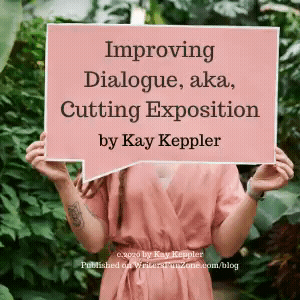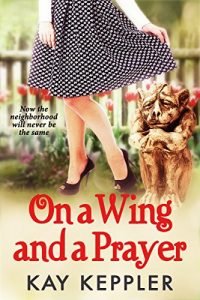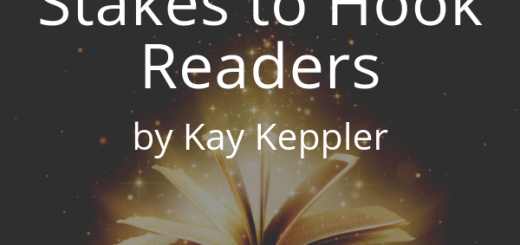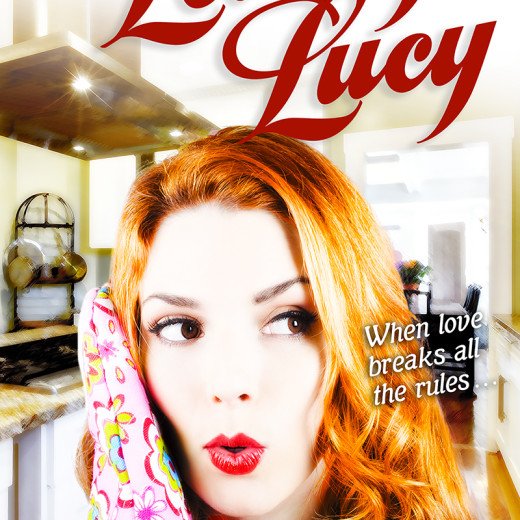Improving Dialogue, aka, Cutting Exposition by Kay Keppler
 Let’s welcome back monthly columnist, editor, and novelist, Kay Keppler, as she shares with us “Improving Dialogue, aka, Cutting Exposition.” Enjoy!
Let’s welcome back monthly columnist, editor, and novelist, Kay Keppler, as she shares with us “Improving Dialogue, aka, Cutting Exposition.” Enjoy!
***
For those of you who occasionally dip into the murky waters of writing advice and aren’t familiar with the work of Chuck Wendig, let me remedy that situation.
Wendig is a prolific writer of science fiction, urban fantasy, and comic books for Marvel and other publishers. He’s written screenplays and has an active blog. His Star Wars novel Aftermath debuted at #4 on both The New York Times and USA Today best seller lists, so you can see he’s got some serious chops.
Advice From a Pro on Dialogue and Exposition
Wendig has also written several books of advice and tips for writers. His advice is brash and his language is profane, but his voice is refreshing and often comforting for writers who are trying to find their way to better writing because he energetically embraces uncertainty and doubt. And if you don’t mind the swearing, he’s funny, too.
I was recently asked to critique a manuscript for its dialogue; the author wanted to reduce the amount of exposition used to convey information.
Exposition is background information, everything that isn’t a part of the story, but is nevertheless important to understand the events.
In the process of doing the critique, I revisited Wendig’s Confessions of a Freelance Penmonkey specifically the chapter called “Characters Make Talky-Talky: Dialogue That Doesn’t Suck Ass.” (See what I mean about the profanity?)
The Pitfalls of Exposition
In that chapter, he discusses the pitfalls of exposition.
Here’s what’s fucked up about dialogue: the rule of writing is show, don’t tell, but dialogue is ultimately an expression of telling. In daily life, I tell people shit all the time. Some guy stops for directions, I tell him how to get to the post office. I don’t show him. I don’t take him on a wondrous visual journey down the back streets and potholed highways, past the meth den and the possum breeders, past Old Man Hymenbreaker’s place, past the bar where Johnny McGlinchey got stabbed in the neck with a shard of Native American pottery. Much as I’d love to, I can’t. So I tell him. Thing is, that’s not going to be that interesting for the audience, is it? Nope.
How do you make dialogue show and not tell?
The answer?
Characters should never speak.
No. No! Wait, that can’t be right.
What I mean to say is, you don’t need to be so concerned with the fact the character is telling. Rather, you need to be concerned with the fact that you, as the writer, are showing.
That doesn’t make much sense yet. I know.
The character can tell. You must show how the character tells.
Better? Still not there? We’re zeroing in on it. Don’t pee your pants.
Let’s assume that Ruth Rumpletits, the Matriarch of Archer Avenue, wants to talk about the history of the town in which she lives, Redlandtownsburg. We know she’s going to convey information, and we know an information dump is a boat anchor that will drag your narrative down. And yet, that infodump contains information that both the reader and the other characters must have. Fine.
How Ruth tells that history is where you have the chance to show and not tell—meaning, it’s your chance to make it interesting.
You will show her mannerisms.
You will show how she tells a story—just as you tell a story, so does she, and the way she tells it is of equal importance to what she tells. Her rules for storytelling are the same as yours, so keep that in mind.
You might show that she’s doing something else as she info-dumps all over the other characters.
Just as many games feature mini-games, your big story will feature lots of mini- and micro-stories, and as Ruth tells her story, she might be cooking some eggs. Maybe she can’t find the eggs, or she burns her hand, or she suddenly freaks out from some acid flashback and she throws searing hot omelette cheese into one of the other main character’s eyes. Dialogue can be immediately punctuated by action—you’re showing what she’s doing as she tells her story. (Plus, action breaks up dialogue, which can be useful.)
One more thing:
Remember: exposition and information are sometimes necessary, but it forces you to go the extra mile to be interesting. Hence, do not overuse. I’m not saying “avoid like the plague,” but I am cautioning you not to rely on it, lest you perforate the drama of your story and let all the air out of the narrative.
Making Dialogue Interesting When the Words Aren’t
How does that advice work for you? I liked it for its extended, graphic examples of what Ruth does while she’s cooking the eggs, and I think it shows how you can make dialogue interesting even when the speaker’s words aren’t that compelling.
Wendig’s advice—or his voice—might not be for everyone. But for those who don’t mind a salty overtone, his work might be just to your taste.
***
ABOUT THE AUTHOR
 Kay Keppler is an author Zero Gravity Outcasts, Betting on Hope, Gargoyle: Three Enchanting Romance Novellas, and editor of fiction and nonfiction –Angel’s Kiss and Outsource It!
Kay Keppler is an author Zero Gravity Outcasts, Betting on Hope, Gargoyle: Three Enchanting Romance Novellas, and editor of fiction and nonfiction –Angel’s Kiss and Outsource It!
She lives in northern California. Contact her here at Writer’s Fun Zone in the comments below, or at kaykeppler@yahoo.com to ask questions, suggest topics, or if you prefer, complain.
***
More popular articles by Kay Keppler on Writer’s Fun Zone:





